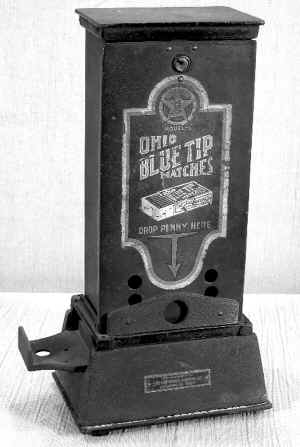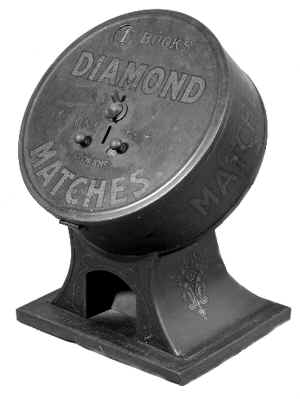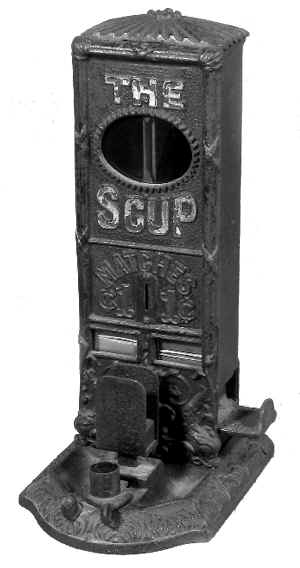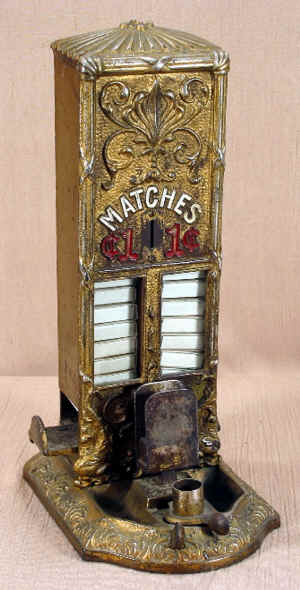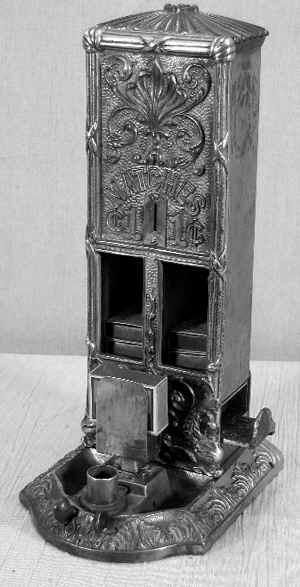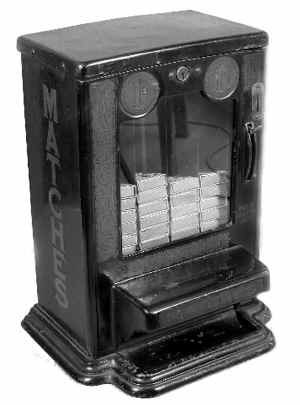|
A Penny Light
One of the first of these match venders was the Sellem, first produced around 1911 by the Northwestern Corporation of Chicago, which also produced a varied line of gumball machines, stamp vending machines, and a second line of match venders called the "Penny Matches." The Sellem model stood 13½ inches high and held about two dozen small cardboard boxes of matches. Northwestern released 70 different machines under the Sellem name. The Sellem machine was the deluxe model of the Northwestern match vendor line. Northwestern made the top, front and base of its Sellem machine from cast iron in the ornate Art Nouveau style and attached them each other to form one unit. The rear compartment housed two columns. The "column" part of the rear unit was made of tin or sheet metal, and the bottom "mechanism" part is cast iron. Two dolphins decorated the fronts of some of the models. The Sellem was the firm’s only model to have a cigar cutter and matchbox holder, both of which enticed customers to the machine and reminded them to buy a box of matches.
The Sellem could be converted to standard or half-size boxes, and a later version offered two boxes for a nickel. Northwestern originally painted its Sellems with white or green enamel, but later models came in antique silver. Some Sellems had a large advertising marquee that formed an upside down "U" and framed the front of the machine. When a gentleman inserted a penny, it would drop through the wooden piece and allow the push bar to go back and forth. The machine also had a removable match loading compartment which often is missing on ones appearing for sale today. The cigar tip cutter was an added feature that enabled smokers to prepare their cigars before lighting. Sellem vending machines sell for between $300 and $400. However, a fine one sold at auction for $960, but that’s rare.
The Advance Machine Company, also of Chicago, manufactured a larger 17½ -inch-tall match vender for the Atlas Manufacturing Company of Cincinnati, Ohio, which is what's embossed into the base. This was a solid, heavy cast-iron dome machine and was one of the most impressive match vendors available. Smokers inserted a penny and pulled the lever which made the stacks rotate a quarter turn and drop a pack of matches into the front dish. These also came painted green. And while they’re not particularly common, they are available and many still have their original paint. Some have the word "MATCHES" stenciled vertically on the side of each column, but these machines also came with paper labels saying the same thing in the same location.
The Columbus Vending Company, of Columbus, Ohio, also produced a number of match vending machines, beginning in 1913. Its first model was a short-lived machine produced only in 1913 and 1914. Another model took its place the following year. It had two columns and dispensed matchboxes into the center instead of each side. The company’s model produced in 1928 was one of its more common ones. It also dispensed matches into the center section rather than each side, as did the previous model. It had a cast iron base and a sheet metal body, so it was a relatively heavy machine. The round Diamond Match vendor, made by Beaton & Caldwell Company in the 1920s, came in two variations. An earlier, less common, slanted version and its successor, a straight vertical version. Though the straight version was interesting and had similar graphics as the slanted version, the angle on it a neat design twist. Smokers inserted a penny into the slot, squeezed the two small round knobs together, causing the right knob and the vending wheel inside the machine to move clockwise a small distance—just far enough to release a book of matches into the receptacle below. The right-hand knob---but not the vending wheel inside---then retreated back to its starting position to await the next customer. Beaton made the machine of thick sheet metal and painted it red.
The International Vending Company made a four-column vendor with the columns nestled between the big "SAFETY MATCHES 1¢ BOX" placards in 1910. This vender had a fringed lampshade on top. International made a match vender in 1910 as a private label for the Ideal Manufacturing Company and the Jackson Vending Company of Chicago. However, it didn’t say Ideal or Jackson anywhere on it, but the coin slot did say it was the property of the Indianapolis Concession Company, and the underside of the wood coin box said it was "sold by E.K. Rahke, Jobber, 137 West Market Street." The Northwestern Corporation of Morris, Illinois, produced a private-label Sellum match vending machine called the Scup. The only difference between it and its Sellem model was the top part of the front casting above the windows. It originally came with a paper-on-tin-backing fish emblem in that window.
As an avid collector of a variety of antiques and collectibles for the last 20 years, Bob Brooke knows what he’s writing about. Besides writing about antiques, Brooke has also sold at flea markets and worked in an antique shop, so he knows the business side too. His articles have appeared in many antiques and consumer publications, including British Heritage, Antique Week, Southeastern Antiquing and Collecting Magazine, www.OldandSold.com, and many others. To read more of his work, visit his main website at www.bobbrooke.com or his specialty antiques site at www.theantiquesalmanac.com PHOTO CAPTIONS: The Columbus Vending Company, of Columbus, Ohio, also produced a number of match vending machines. This is their No. 25 model. The round Diamond Match vendor, made by Beaton & Caldwell Company in the 1920s, came in two variations. This is the less common, slanted version. Northwestern produced the "Scup," a third version of its Sellum machine, for a private company. The Sellem was one of the most common match vending machines and one of the most elegant. The Sellem came in green, orange, and antique or nickeled silver. Some match machines had four columns of matches which enabled them to be filled less often. |
